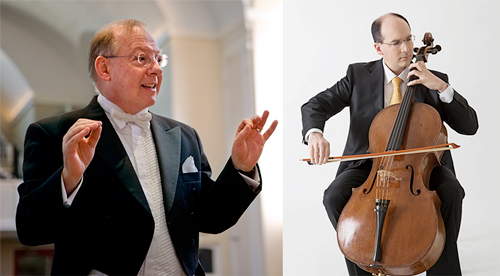by Nicholas Jones

British conductor Nicholas McGegan is one of our great leaders of baroque music on period instruments (for thirty years, he has been music director of the very successful San Francisco Philharmonia Baroque orchestra). Leading the Cleveland Orchestra this weekend, he showed that he also has a deft touch in facilitating historically-informed performances from players on modern instruments. Enthusiastic, precise, and expressive, McGegan encouraged sharp articulations and snappy rhythms from a band of about forty players—less than half the size of the usual Severance Hall forces.
The program, which ran about 75 minutes with no intermission, included a welcome variety of essentially cheerful music. It began with a selection from George Frederick Handel’s Water Music (the second suite in D), comprising five celebratory movements. The winds (oboes and bassoon) and brass (trumpets and horns) supplied the requisite reminder of the public, outdoor character of Handel’s tribute to King George (the first performance featured musicians on a barge on the Thames, playing both to the court on another barge and to Londoners on the river banks). McGegan took the opening movement—for which Handel gives no tempo indication—at an overly brisk pace, but the succeeding sections were paced just right: including a vivacious hornpipe, a courtly and up-tempo minuet, a gracious loure (a slow gigue), and a colorful bourrée full of contrasting orchestral sounds.
Franz Joseph Haydn’s Cello Concerto in C, lost for two centuries, has been a staple of the concert repertoire since its rediscovery in the early 1960s. With the transparency often associated with the key of C, this tuneful concerto features balance and delicacy over drama and passion. In the hands of Cleveland Orchestra principal cello Mark Kosower, Haydn’s graceful artistry was fully evident. Though the part is demanding, especially in its continued placement in the high registers, Kosower’s playing sounded effortless, even relaxed, while never letting go of Haydn’s energetic rhythms.
The small orchestra (oboes, horns, and strings) stayed out of the way of the soloist so that almost every detail of the delightfully inventive solo line could be heard. Kosower’s cadenza for the first movement explored the darker side of some of the motifs, such as a sequence of repeated sixteenth-notes on the lower strings, adding some edgy post-classical techniques and harmonies. His choice was probably intended as a contrast, but for me, the cadenza was incompatible with the generally sunny quality of Haydn’s writing in the rest of the performance. A lyrical second movement reestablished the balance, and a splendidly virtuosic finale showed off Kosower’s vivid and stirring mastery of the classical style.
With barely a pause to shift the stage, McGegan swept into the final piece, Schubert’s Symphony No. 5 in B-flat. Coming after the Handel and the Haydn, this youthful masterpiece (the composer was all of 19 years old!) comes with a startlingly new sound, marked by Beethoven-like contrasts and expressive harmonic modulations.
Schubert achieves a remarkable Romantic coloration of the orchestral sound by adding a single flute (played here by assistant principal Marisela Sager) to the paired oboes, horns, and bassoons. This was an elegant performance, highlighted by delicate string playing, and gorgeous counterpoint among the winds and horns. The first and last movements were both rich with Schubertian melody and pulse. As the program notes remarked, the third movement is clearly an homage to the minuet in Mozart’s G-minor symphony (number 40); McGegan made sure that Schubert’s minuet had a danceable sprightliness to complement its show-off complexity.
The second movement of the Schubert moves through a series of remarkable, expressive modulations from its home key of E-flat major (three flats) to the remote key of C-flat major (seven flats!). Paradoxically, these difficult tunings were played almost too perfectly on the orchestra’s modern instruments: earlier flutes, oboes, and bassoons, lacking the complicated keying that lets one play easily in any key, would have projected these changes with the sense of being suddenly and surprisingly thrust into startling harmonic waters.
The program as a whole was a welcome finale to the Friday night series of Summers@Severance. Keeping the program short enough to proceed without intermission was a definite plus. The vitality of the programming is clearly drawing enthusiastic patrons: the concert appeared to be sold out, and the audience was warm in its applause.
Published on ClevelandClassical.com August 25, 2015.
Click here for a printable copy of this article


